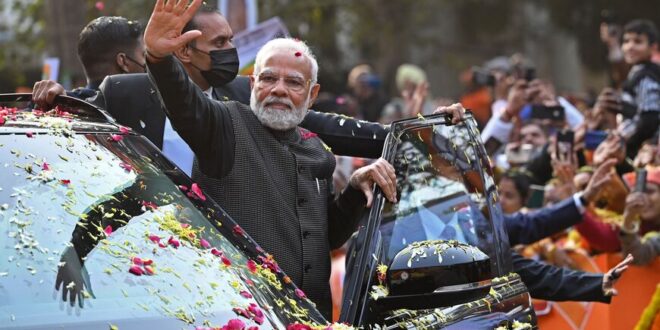This decision by Iranian Foreign Minister Hossein Amir-Abdollahian to boycott a conference in India is a reminder of political, economic and military tensions between the two South Asian countries.
By boycotting a foreign policy conference in New Delhi in February, Iran’s foreign minister may have made latent contradictions in the Indo-Iranian equation even more obvious.
Hossein Amir-Abdollahian suddenly signaled his displeasure over a promotional video shared by the hosts of the Raisina Dialogue and cancelled his trip set for this week. The annual event organized by the Observer Research Foundation (ORF) is held under the auspices of the Indian Ministry of External Affairs (MEA).
The video clip in question, promoting the 2023 edition of the Raisina Dialogue, showed Iranian women protestors cutting off their hair in anti-government rallies alongside an image of Iranian President Ebrahim Raisi. After the ORF refused to remove Raisi’s image from the footage, Tehran informed New Delhi that their foreign minister would not attend.
Since September, Iran has been rocked by protests after the death of Mahsa Amini in police custody. New Delhi has tried to balance its different interests while adjusting its stance to a domestic audience that supports the movement.
At the United Nations, New Delhi abstained from a resolution adopted by the Human Rights Council (UNHRC) in November to set up a fact-finding mission on human rights violations in Iran.
If highlighting the Iran protests was not in line with the official New Delhi stance just months ago, why did India share this video clip?
Afifeh Abedi, a researcher of Iran’s foreign policy in Tehran, told Al-Monitor that the Raisina Dialogue was not very influential for Indo-Iran ties. But, she added, “It was a sign that other factors affect their relationship.”
The Indian Express suggested that the trip was cancelled because “Abdollahian would have surely factored in the likelihood of being questioned about this unprecedented feminist mobilization that continues to roil Iran.”
Muslim Women In India Take Cue From Iran, Set Hijab Ablaze In Kerala As Protests Rock The World.#TNDIGITALVIDEOS #Hijab #Kerala #Iran pic.twitter.com/VMDkYyOaoi
— TIMES NOW (@TimesNow) November 7, 2022During his first trip to India in June 2022, Amir-Abdollahian raised the issue of controversial comments against Prophet Mohammed by two Bharatiya Janata Party spokespersons, but New Delhi did not respond.
Ashok Swain, professor of peace and conflict research at Uppsala University in Sweden, told Al Monitor, “Iran is an Islamic republic, and the Hindu nationalist government in India, for its domestic politics, also gains from highlighting protests against compulsory hijab-wearing.”
Potentially, Indo-Iranian relations can be far-reaching and multi-dimensional, while Tehran’s geographical location extends New Delhi’s geopolitical outreach, India’s vision can make Iran a regional hub for transit and trade, a Brookings study by Kadira Pethiyagoda assessed in 2018.
However, both sides have been unable to derive full benefits due to New Delhi’s relations with Washington and Tel Aviv, and now Iran’s partnership with China.
Another setback in Indo-Iran collaborations has been the breakdown of the Joint Comprehensive Plan of Action (JCPOA) talks.
With Iran’s Chabahar port lying in limbo due to the sanctions on Tehran, long-term Indian ambitions for regional connectivity and trade have been badly affected. Not only was Chabahar supposed to compete with Pakistan’s Gwadar port, a flagship project of the China-Pakistan Economic Corridor, it was to be the main node of a transportation network connecting India to Afghanistan, Central Asia, Russia and Europe.
Expecting some progress in the JCPOA talks, New Delhi had allocated 1 billion rupees (about $12.1 million) in its 2023-2024 budget for the Iranian port. But if the JCPOA is not revived, Chabahar may become a forgotten chapter in Indo-Iranian ties.
In addition, the sanctions affected New Delhi’s energy security, as Iran used to be its second largest oil supplier. Since mid-2019, India completely stopped buying Iranian oil, but it continued to source oil from Russia despite sanctions after it attacked Ukraine.
Abedi noted that the relationship between India and the US has also made Indo-Iranian ties more complex. She added, “It seems that China has [also] been added to the factors affecting Indo-Iran relations, but now the completion of several geo-economic projects is in the interest of both countries.”
Also, Iran may view the I2U2, a new coalition between India, Israel, the US and the UAE with suspicion. Focusing on maritime security, infrastructure, transport and trade, the four-member group is similar to the Quad while it furthers the vision of the Abraham Accords with economic development. Advancing New Delhi’s Middle East Policy, the I2U2 can prove to be an alternate option to its geo-economic initiatives with Iran.
Finally, India and Iran have had a defense pact, the New Delhi Declaration, since 2003, but their strategic cooperation has been at a low level, even though both countries could have played a significant role in stabilizing Afghanistan.
Tehran’s 25-year comprehensive strategic partnership with China has pushed New Delhi even further in the background. According to unofficial reports, Tehran has recently offered a China-style 25-year deal to New Delhi as well. But wishing to move ahead with the China deal, Iranian President Ebrahim Raisi recently visited Beijing for a further upgrade in Sino-Iran relations.
According to Swain, “India’s relations with Iran are complicated, to say the least. While India wants to maintain a cooperative relationship with Iran to create a front vis-a vis Pakistan-Afghanistan in the region, it is also increasingly worried about Iran’s alliance with China. India is also under pressure from the US against any cooperation with Iran.”
Having established six border markets, Iran is also promoting barter trade with Pakistan, and it will be providing uninterrupted electricity to Gwadar port.
But notwithstanding all the contradictions, Iran’s annual exports to India spiked by 60% in 2022. Only last week, the Iranian foreign ministry held a session on economic ties in which the participants “underlined the importance of India in Iran’s foreign policy.”
India’s foreign ministry spokesperson, Arindam Bagchi, did not respond to requests for comment.
 Eurasia Press & News
Eurasia Press & News


